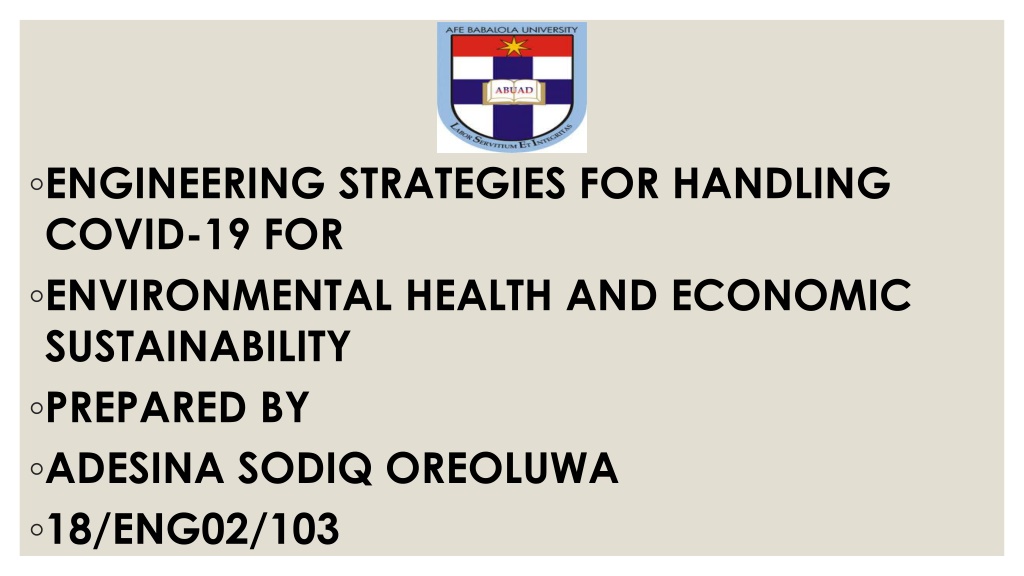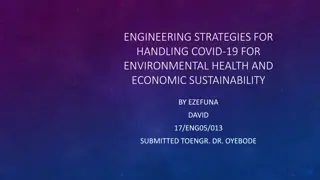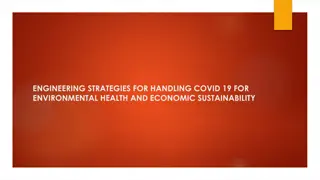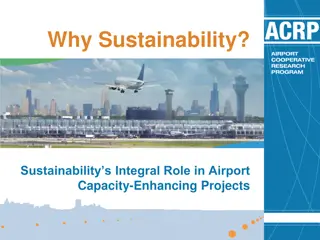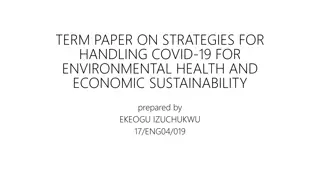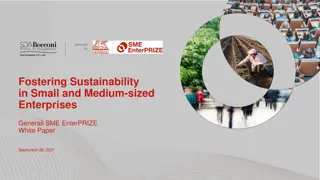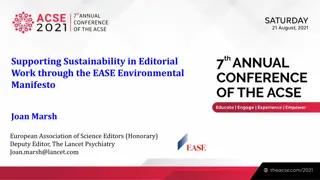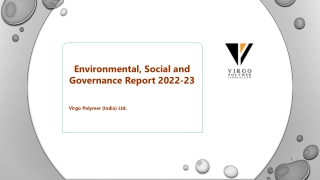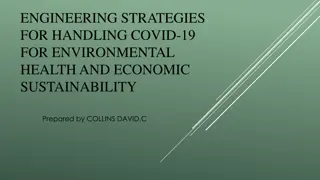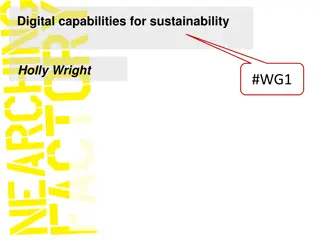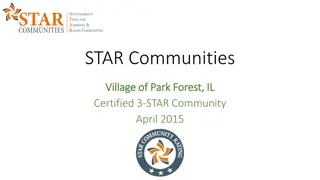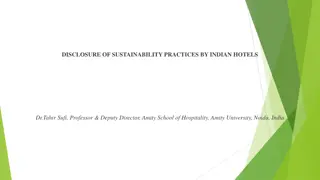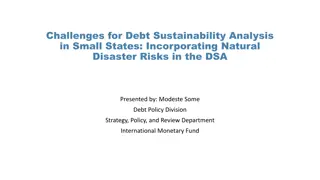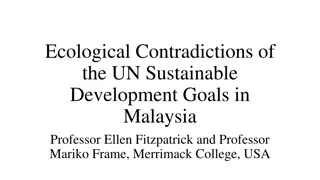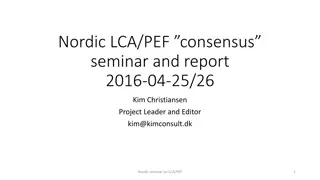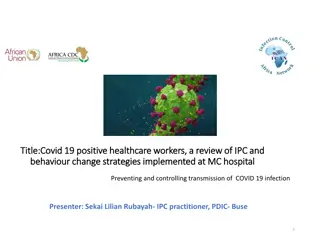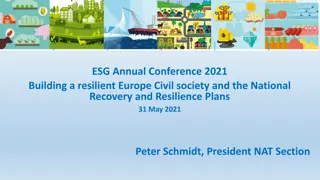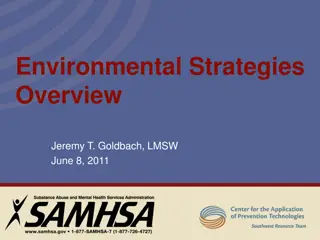Engineering Strategies for COVID-19: Enhancing Environmental and Economic Sustainability
This term paper explores strategies for managing COVID-19 to safeguard environmental health and economic sustainability. It emphasizes the need for a multidisciplinary approach, beyond medical interventions, to address the pandemic's societal and economic impact effectively.
Download Presentation

Please find below an Image/Link to download the presentation.
The content on the website is provided AS IS for your information and personal use only. It may not be sold, licensed, or shared on other websites without obtaining consent from the author. Download presentation by click this link. If you encounter any issues during the download, it is possible that the publisher has removed the file from their server.
E N D
Presentation Transcript
ENGINEERING STRATEGIES FOR HANDLING COVID-19 FOR ENVIRONMENTAL HEALTH AND ECONOMIC SUSTAINABILITY PREPARED BY ADESINA SODIQ OREOLUWA 18/ENG02/103
SUBMITTED TO THE DEPARTMENT OF ELECTRICAL ELECTRONICS ENGINEERING COLLEGE OF ENGINEERING, AFE BABALOLA UNIVERSITY, ADO-EKITI, EKITI STATE, NIGERIA
ABSTRACT This term paper describes the details of covid-19 and the strategies for handling the pandemic and managing environmental and economic sustainability as the disease endangers the lives and the economic conditions of a country and the control of the virus will come with an enormous economic and social price. Focusing on pandemic influenza, this chapter approaches the planning for and response to such a major worldwide health event as a complex engineering systems problem. Action- oriented analysis of pandemics requires a broad inclusion of academic disciplines since no one domain can cover a significant fraction of the problem. Numerous research papers and action plans have treated pandemics as purely medical happenings, focusing on hospitals, health care professionals, creation and distribution of vaccines and anti-viral, etc. But human behavior regarding hygiene and social distancing constitutes a first-order partial brake or control of the spread and intensity of infection.
ACKNOWLEDGEMENTS All glory and praise be to the Almighty God for his favour and grace upon my life and for the wisdom, knowledge and understanding he has given to me from onset till now. I would love to acknowledge my parents and family for their support and sacrifices they continually provide.
TABLE OF CONTENTS CERTIFICATION ABSTRACT ACKNOWLEDGEMENTS LIST OF FIGURES INTRODUCTION 1.1 WHAT IS CORONA VIRUS (COVID-19)? 1.1.1 SIGNS AND SYMPTOMS 1.1.2 CAUSES AND TRANSMISSION 1.1.3 PREVENTION 2 LITERATURE REVIEW 2.1 ENVIRONMENTAL HEALTH 2.1.1 DISCIPLINES 2.1.2 CONCERNS 2.2 ECONOMIC SUSTAINABILITY 3 METHODOLOGY 3.1 ENGINEERING STRATEGIES 4 RESULTS CONCLUSION 5 CONCLUSION AND RECOMMENDATION 5.1 RECOMMENDATION 6 REFERENCE6
LIST OF FIGURES Figure 1: corona virus Figure 2: preventions Figure 3:Air pollution is an example of an exposure that has been linked with negative health outcomes. Figure 4: toxicology Figure 5: Exposure science Figure 6: Environmental engineering Figure 7: Engineering law Figure 8: environmental health Figure 9:EPIDEMOLOGY Figure 10: mechanical ventilation
INTRODUCTION WHAT IS CORONA VIRUS (COVID-19)? Coronavirus disease (COVID-19) is an infectious disease caused by a newly discovered coronavirus. Most people infected with the COVID-19 virus will experience mild to moderate respiratory illness and recover without requiring special treatment. Older people, and those with underlying medical problems like cardiovascular disease, diabetes, chronic respiratory disease, and cancer are more likely to develop serious illness. The best way to prevent and slow down transmission is be well informed about the COVID-19 virus, the disease it causes and how it spreads. Protect yourself and others from infection by washing your hands or using an alcohol based rub frequently and not touching your face. The COVID-19 virus spreads primarily through droplets of saliva or discharge from the nose when an infected person coughs or sneezes, so it s important that you also practice respiratory etiquette (for example, by coughing into a flexed elbow). At this time, there are no specific vaccines or treatments for COVID-19. However, there are many ongoing clinical trials evaluating potential treatments. WHO will continue to provide updated information as soon as clinical findings become available.
SIGNS AND SYMPTOMS The COVID-19 virus affects different people in different ways. COVID-19 is a respiratory disease and most infected people will develop mild to moderate symptoms and recover without requiring special treatment. People who have underlying medical conditions and those over 60 years old have a higher risk of developing severe disease and death. Common symptoms include: fever tiredness dry cough. Other symptoms include: shortness of breath aches and pains sore throat and very few people will report diarrhea, nausea or a runny nose. People with mild symptoms who are otherwise healthy should self-isolate and contact their medical provider or a COVID-19 information line for advice on testing and referral. People with fever, cough or difficulty breathing should call their doctor and seek medical attention.
CAUSES AND TRANSMISSION Human-to-human transmission has been confirmed during the 2019 20 coronavirus pandemic. Transmission occurs primarily via respiratory droplets from coughs and sneezes within a range of about 1.8 metres (6 ft.). Indirect contact via contaminated surfaces is another possible cause of infection. Preliminary research indicates that the virus may remain viable on plastic and steel for up to three days, but does not survive on cardboard for more than one day or on copper for more than four hours; the virus is inactivated by soap, which destabilises its lipid bilayer. Viral RNA has also been found in stool samples from infected people.
PREVENTION Preventive measures include: Avoid close contact (1 meter or 3 feet) with people who are unwell. Stay home and self-isolate from others in the household if you feel unwell. Don't touch your eyes, nose, or mouth if your hands are not clean. Frequently wash your hands with soap and water for at least 20 seconds. When soap and running water are unavailable, use an alcohol-based hand rub with at least 60% alcohol. Always wash hands that are visibly soiled. Practice good respiratory etiquette, including covering coughs and sneezes. Recognize personal risk factors. According to U.S. Centers for Disease Control and Prevention (CDC), certain people, including older adults and those with underlying conditions such as heart or lung disease or diabetes, are at higher risk for developing more serious complications from COVID- 19.
LITERATURE REVIEW ENVIRONMENTAL HEALTH Environmental health is the branch of public health concerned with all aspects of the natural and built environment affecting human health. Environmental health is focused on the natural and built environments for the benefit of human health. The major sub disciplines of environmental health are: environmental science; environmental and occupational medicine, toxicology and epidemiology. Five basic disciplines generally contribute to the field of environmental health: environmental epidemiology, toxicology, exposure science, environmental engineering, and environmental law. Each of these disciplines contributes different information to describe problems and solutions in environmental health, but there is some overlap among them. Environmental epidemiology is a branch of epidemiology concerned with determining how environmental exposures impact human health.[2]This field seeks to understand how various external risk factors may predispose to or protect against disease, illness, injury, developmental abnormalities, or death. These factors may be naturally occurring or may be introduced into environments where people live, work, and play.
Figure 3:Air pollution is an example of an exposure that has been linked with negative health outcomes. Toxicology studies how environmental exposures lead to specific health outcomes, generally in animals, as a means to understand possible health outcomes in humans. Toxicology has the advantage of being able to conduct randomized controlled trials and other experimental studies because they can use animal subjects.
Exposure science studies human exposure to environmental contaminants by both identifying and quantifying exposures. Exposure science can be used to support environmental epidemiology by better describing environmental exposures that may lead to a particular health outcome, identify common exposures whose health outcomes may be better understood through a toxicology study.
Environmental engineering applies scientific and engineering principles for protection of human populations from the effects of adverse environmental factors; protection of environments from potentially deleterious effects of natural and human activities; and general improvement of environmental quality.
Engineering law includes the network of treaties, statutes, regulations, common and customary laws addressing the effects of human activity on the natural environment.
CONCERNS Environmental health addresses all human-health-related aspects of the natural environment and the built environment. Environmental health concerns include: Air quality, including both ambient outdoor air and indoor air quality, which also comprises concerns about environmental tobacco smoke. Biosafety Disaster preparedness and response. Climate change and its effects on health.
Environmental racism, wherein certain groups of people can be put at higher risk for environmental hazards, such as air, soil, and water pollution. This often happens due to marginalization, economic and political processes, and ultimately, racism. Environmental racism disproportionately affects different groups globally, however generally the most marginalized groups of any given region/nation. Food safety, including in agriculture, transportation, food processing, wholesale and retail distribution and sale. Hazardous materials management, including hazardous waste management, contaminated site remediation, the prevention of leaks from underground storage tanks and the prevention of hazardous materials releases to the environment and responses to emergency situations resulting from such releases. Housing, including substandard housing abatement and the inspection of jails and prisons. Childhood lead poisoning prevention. Land use planning, including smart growth. Liquid waste disposal, including city waste water treatment plants and on-site waste water disposal systems, such as septic tank systems and chemical toilets. Medical waste management and disposal. Noise pollution control.
Environmental racism, wherein certain groups of people can be put at higher risk for environmental hazards, such as air, soil, and water pollution. This often happens due to marginalization, economic and political processes, and ultimately, racism. Environmental racism disproportionately affects different groups globally, however generally the most marginalized groups of any given region/nation. Food safety, including in agriculture, transportation, food processing, wholesale and retail distribution and sale. Hazardous materials management, including hazardous waste management, contaminated site remediation, the prevention of leaks from underground storage tanks and the prevention of hazardous materials releases to the environment and responses to emergency situations resulting from such releases. Housing, including substandard housing abatement and the inspection of jails and prisons. Childhood lead poisoning prevention. Land use planning, including smart growth. Liquid waste disposal, including city waste water treatment plants and on-site waste water disposal systems, such as septic tank systems and chemical toilets.
METHODOLOGY ENGINEERING STRATEGIES The basic strategies in the control of an outbreak are containment and mitigation. Containment may be undertaken in the early stages of the outbreak, including contact tracing and isolating infected individuals to stop the disease from spreading to the rest of the population, other public health interventions on infection control, and therapeutic countermeasures such as vaccinations which may be effective if available. When it becomes apparent that it is no longer possible to contain the spread of the disease, management will then move on to the mitigation stage, in which measures are taken to slow the spread of the disease and mitigate its effects on society and the healthcare system. In reality, containment and mitigation measures may be undertaken simultaneously. Another strategy, suppression, requires more extreme long-term non-pharmaceutical interventions so as to reverse the pandemic by reducing the basic reproduction number to less than 1. The suppression strategy, which includes stringent population-wide social distancing, home isolation of cases, and household quarantine, was undertaken by China during the 2019 20 coronavirus pandemic where entire cities were placed under lockdown, but such strategy carries with it considerable social and economic costs. Some of the engineering strategies employed in this current situation are: Epidemiology is the study and analysis of the distribution (who, when, and where), patterns and determinants of health and disease conditions in defined populations. Major areas of epidemiological study include disease causation, transmission, outbreak investigation, disease surveillance, environmental epidemiology, forensic epidemiology, occupational epidemiology, screening
of treatment effects such as in clinical trials. Epidemiologists rely on other scientific disciplines like biology to better understand disease processes, statistics to make efficient use of the data and draw appropriate conclusions, social sciences to better understand proximate and distal causes, and engineering for exposure assessment.
MANUFACTURING: Due to capacity limitations in the standard supply chains, some digital manufacturers are printing healthcare material such as nasal swabs and ventilator parts. EXPERIMENTAL TESTING: No medications are approved to treat the disease by the WHO although some are recommended by individual national medical authorities. Research into potential treatments started in January 2020, and several antiviral drugs are in clinical trials. Although new medications may take until 2021 to develop, several of the medications being tested are already approved for other uses or are already in advanced testing.
INFORMATION TECHNOLOGY: In February 2020, China launched a mobile app to deal with the disease outbreak. Users are asked to enter their name and ID number. The app is able to detect 'close contact' using surveillance data and therefore a potential risk of infection. Every user can also check the status of three other users. If a potential risk is detected, the app not only recommends self-quarantine, it also alerts local health officials. Big data analytics on cell phone data, facial recognition technology, mobile phone tracking and artificial intelligence are used to track infected people and people whom they contacted in South Korea, Taiwan and Singapore. In March 2020, the Israeli government enabled security agencies to track mobile phone data of people supposed to have coronavirus. The measure was taken to enforce quarantine and protect those who may come into contact with infected citizens. Also in March 2020, Deutsche Telekom shared aggregated phone location data with the German federal government agency, Robert Koch Institute, in order to research and prevent the spread of the virus. Russia deployed facial recognition technology to detect quarantine breakers. Italian regional health commissioner Giulio Gallera said he has been informed by mobile phone operators that "40% of people are continuing to move around anyway". German government conducted a 48 hours weekend hackathon with more than 42.000 participants. Also the president of Estonia, Kersti Kaljulaid, made a global call for creative solutions against the spread of coronavirus.
CHAPTER FOUR RESULTS GOOGLE, APPLE NEW CORONA VIRUS TRACKING SYSTEM: Apple and Google have announced they are developing a new system to track the spread of the novel coronavirus, which will help users share data via Bluetooth Low Energy (BLE) transmissions, and other apps approved by health organizations. The new tracking system will use short-range communications via Bluetooth to establish voluntary networks that trace recent contacts and archive extensive data on phones that have been in close proximity to one another, reports The Verge. Apps put out by public health authorities will also have full access to the data, and users who download the apps may report if they have been diagnosed with the COVID-19 illness. The new tracking system will also alert those who downloaded them to check if they've been in close contact with an infected person. INNOVATIVE FACE MASK FOR THE HEARING IMPAIRED: The masks have a transparent section over the mouth for the hearing impaired to read lips. The masks also allow people to see the wearer's facial expressions, which is crucial when using Sign Language. MECHANICAL VENTILATION: Most cases of COVID-19 are not severe enough to require mechanical ventilation (artificial assistance to support breathing), but a percentage of cases do. It has been recommended for the use of invasive mechanical ventilation because this technique limits the spread of aerosolised transmission vectors.
S1600 ICU Ventilator Machine - Local Medical Surgical Machine Form ...
CONCLUSION CONCLUSION AND RECOMMENDATION The study shows the positive impact of quarantine in decreasing the number of confirmed cases, which was effective after about 14 days, alongside the impact of environmental factors in confirmed cases of COVID- 19 and the role of regression analysis and binary classification by using artificial intelligence in the investigations. we strongly believe that the above mentioned strategies of engineering in handling the pandemic situation are effectively been carried out to help the victims as well as the rest of the world in taking preventive measures. RECOMMENDATION With respect to the current situation, I recommend the following: People should strictly adhere to the WHO instructions and guidance. People should follow and obey the country s order and protocols. Governments in the country should take responsibility and provide for her citizens, especially those with little or no means of provision. People should use this medium to be creative and engage in one form of activity (legal) or the other from their various homes. Provide isolation rooms that are well ventilated (wide open windows that open to the outside, away from other wards with doors closed and preferably with an ante-room. Rooms should provide air flow of at least 160 L/s per patient with at least 12 air exchanges per hour and controlled direction of air flow (air flow should be away from the healthcare worker towards the patient to the outside through the open window. Air should not flow from the patients room into the hallway or other rooms/wards.
REFERENCE corono virus diseas 2019. (2020, april 10). Retrieved april 10, 2020, from wikipedia: https://en.wikipedia.org/wiki/Coronavirus_disease_2019#Other environmental health. (2020, april 8). Retrieved april 10, 2020, from wikipedia: https://en.wikipedia.org/wiki/Environmental_health industry: interesting engineering. (2020, april 4). Retrieved april 11, 2020, from interesting engineering: https://interestingengineering.com pandemic. (2020, april 11). Retrieved april 11, 2020, from wikipedia: https://en.m.wikipedia.org/wiki/Pandemic what is economic sustainability? (n.d.). Retrieved april 10, 2020, from wisegeek: https://www.wisegeek.com
